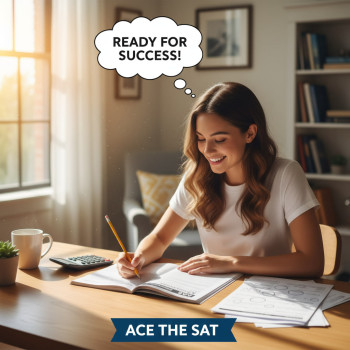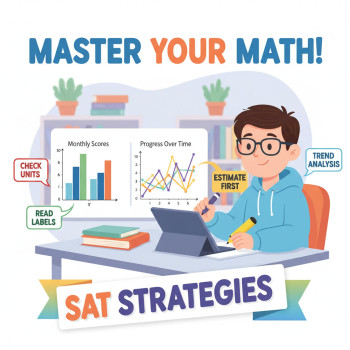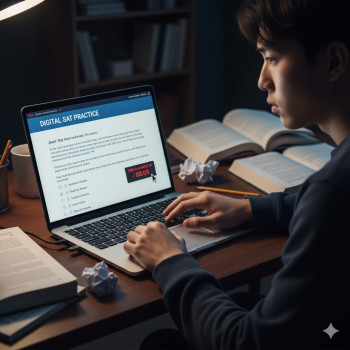Why free resources are your smartest first move
If you’re getting ready for the Digital SAT, you might be tempted to scroll through ads for flashy courses and expensive bundles. Before you reach for your wallet, take a breath. A huge portion of what helps students succeed is smart, consistent practice — and the College Board plus trusted partners provide a remarkably robust set of free materials designed exactly for the digital test. With a clear plan and a few smart choices, those free tools can get you a surprisingly long way — often all the way to your target score.
Reality check: quality beats quantity
Not all practice is created equal. An hour of focused, active practice with official questions and thoughtful review is far more powerful than multiple hours of passive review. The free, official resources give you the right kind of practice: authentic questions, realistic test formats, and diagnostic feedback you can act on. So the question becomes less “Do I have enough resources?” and more “Am I using the right ones, consistently and smartly?”
The essential free toolkit (what you should use and why)
Here’s a compact list of the free, high-value resources every Digital SAT student should know about — and how each fits into your study plan.
- Official Digital Practice Tests (Bluebook app): The closest thing to the real exam. Practice adaptive sections, try the testing interface, and learn the timing and navigation mechanics that matter on test day.
- Official SAT Practice on Khan Academy: Personalized study plans, video lessons, practice questions, and full-length tests—all free. It connects with official score reports and helps you target your weakest areas.
- College Board’s My Practice and Student Question Bank: A place to see practice test results, access curated question sets, and drill specific skills where you need the most improvement.
- Downloadable practice tests and scoring guides: For when you want printable PDFs to simulate a quiet testing environment or to review problems on paper.
- BigFuture planning tools and guides: Resources to help set target scores, understand the test structure, and map scores to college goals.
Why start with official materials?
Official materials are written by the makers of the test and reflect the exact style and thinking the test requires. That means you’re not learning strange tricks that won’t transfer to test day — you’re training on the same patterns, vocabulary, and reasoning the Digital SAT uses.

A practical, 12-week plan using only free resources
Here’s a study sequence that balances content review, active practice, and realistic test simulation. Pick a weekly schedule that fits your life (e.g., 8–10 hours/week for busy students, 12–16+ for an intensive ramp-up).
Weeks 1–2: Baseline and familiarization
- Take one adaptive full-length practice test on the Bluebook app to experience the digital format and get baseline data.
- Link your College Board score data to Khan Academy if possible so it can create a personalized plan.
- Spend short daily sessions (30–60 minutes) watching targeted Khan Academy videos for your weakest sections.
Weeks 3–6: Skill-building with targeted practice
- Follow Khan Academy’s personalized practice plan: mix short lessons, item-level practice, and mini-quizzes.
- Use the Student Question Bank to build focused sets (e.g., linear equations, primary-source reading, expression interpretation).
- Every other week, take a timed section or two in Bluebook to practice pacing.
Weeks 7–9: Full-length simulation and review cycles
- Take one full adaptive practice test every 10–14 days in Bluebook under realistic conditions.
- After each test, spend 1–2 sessions reviewing every missed question: why the correct answer works, and why the others don’t.
- Gradually reduce study scope to the most frequent trouble spots, using Khan Academy drills.
Weeks 10–12: Final polish and strategic prep
- Work on timing strategies, triage (which question types to skip and return to), and test-day routines.
- Do 2–3 last full-length Bluebook practice tests spaced with light review days in between.
- Use BigFuture tools to finalize test-day logistics (what to bring, arrival times) and revisit score goals.
Sample weekly schedule (8–12 hour option)
| Day | Activity | Duration |
|---|---|---|
| Monday | Khan Academy targeted practice (math or reading) | 60–90 min |
| Wednesday | Question Bank drills + quick review of errors | 60 min |
| Friday | Practice section in Bluebook (timed) | 50–80 min |
| Saturday | Lesson videos and concept review; note-taking | 60–90 min |
| Sunday | Light review, vocabulary, and planning for next week | 30–45 min |
How to review practice tests so you actually improve
Taking practice tests is emotional: good scores feel great, low scores sting. The growth happens in the review. Here’s a simple, high-impact routine to follow after every practice test.
Three-step review routine
- Identify error patterns: Mark whether mistakes came from content gaps, misreading, pacing, or careless errors.
- Fix the root cause: If errors are content-based, watch the Khan Academy lesson and do a small practice set on that topic. If they’re pacing-related, practice timed mini-sections of that format.
- Active correction: Re-solve missed questions without looking at answers; write down why the right answer is right and why other choices fail.
Keep an “error log” — a simple notebook or digital doc where you record the question type, the mistake, the fix, and the date. You’ll be surprised how many old errors disappear when you revisit them intentionally.
Time management and pacing strategies for the Digital SAT
The Digital SAT changes the rhythm of the test. Instead of long paper sections, you’ll see shorter, adaptive modules that reward steady accuracy and smart skipping. Here are concrete strategies that translate well into the app environment.
Pacing principles
- Start by quickly scanning each question to categorize it: quick-solve, medium, or time-sink.
- Answer all the quick-solve questions first. They build confidence and score momentum.
- For medium questions, allocate a single round of focused thought. If it’s still unclear, mark and come back.
- Ignore perfectionism on the first pass; your job is to keep a steady scoring rate and avoid getting stuck.
Practice this: “two-pass” method
On your practice section, set a timer for 70% of the total time. In that window, do a fast first pass: solve quick questions and mark medium ones. Use the last 30% of time to work through the marked items. This trains you to triage under pressure and mirrors real test-time decision-making.
Using the Bluebook app and test preview effectively
Bluebook is not just where you take practice tests — it’s the testing environment. Familiarity with the interface eliminates avoidable stress. Use the test preview and at least one full adaptive practice test in Bluebook before test day. Practice navigating passages, flagging questions, using calculator tools (if applicable), and typing or marking your answers.

Stretch your free resources: study hacks to get more value
Free resources are powerful — but you can amplify them with a few study habits that turn passive practice into accelerated improvement.
Active recall and spaced repetition
- Take notes in question-answer format. Later, quiz yourself without looking. This strengthens memory far more than rereading.
- Space reviews: come back to the same concept several days later. Khan Academy’s adaptive plan helps here, but your error log and flashcards will too.
Simulate testing conditions
Full-score practice matters less than realistic practice. When you run a mock test, sit in a quiet room, time yourself precisely, and avoid phone interruptions. Use the Bluebook app to replicate the digital environment.
Peer teaching
Explaining a tricky reading passage or math solution to a friend forces clarity. Create short peer study sessions where each person teaches one concept — you’ll remember far more after teaching than after passive review.
When to add paid support — and how free resources prepare you for tutoring
Many students will reach important goals using only free tools. But if you’ve plateaued for several weeks despite focused effort, or you want structured accountability, one-on-one tutoring can speed progress. Free resources make tutoring more efficient: they provide diagnostics and a record of what you’ve already learned, so a tutor can target your needs instead of reteaching basics.
Where Sparkl can fit naturally
If you choose to add personalized help, consider tutors who use your official practice data and work alongside the free tools you already trust. Sparkl’s personalized tutoring offers 1-on-1 guidance, tailored study plans, expert tutors, and AI-driven insights that can complement your free practice. Sparkl tutors can help interpret your Bluebook results, build custom practice sets from the Student Question Bank, and keep your review cycles focused and efficient. Mentioning Sparkl here isn’t about replacing free tools — it’s about using targeted human support to make your free study time more effective.
Common pitfalls and how to avoid them
Even with the best free materials, students stumble on a few predictable problems. Here’s how to avoid them.
- Pitfall: Overdoing untargeted practice. Fix: Follow Khan Academy’s personalized plan and limit general practice to short bursts; prioritize weaknesses.
- Pitfall: Not reviewing mistakes thoroughly. Fix: Use the three-step review routine and keep an error log.
- Pitfall: Ignoring the test interface. Fix: Do at least two full adaptive Bluebook tests to get comfortable with the app and navigation tools.
- Pitfall: Burnout from cramming. Fix: Build recovery days into your schedule and use spaced repetition instead of marathon sessions.
Measuring progress: what metrics to track
Focus on trends, not single numbers. A single practice test is just a snapshot; improvement is shown by consistent upward movement in your sectional strengths and fewer repeated error types.
| Metric | How to track | Why it matters |
|---|---|---|
| Sectional accuracy | Record percent correct per section after each full test | Shows which areas are improving and which need more focus |
| Time per question | Average seconds per question for each question type | Helps refine pacing strategies |
| Error type frequency | Use an error log to mark content vs. careless vs. pacing errors | Targets review habits and prevents repeated mistakes |
| Practice consistency | Number of study hours per week | Consistency beats intensity for long-term gains |
Real-world examples: small changes that make big gains
Consider these small, repeatable shifts students have used to move a score band or two:
- Switching to timed mini-sections twice a week to fix pacing — moved from missing 6–8 questions to missing 2–3.
- Turning every missed question into a 10-minute mini-lesson: re-watching one short Khan Academy video and doing five similar problems — resulted in reliable improvement on that topic within two weeks.
- Using peer teaching for reading passages once a week — improved inference and main-idea accuracy through active discussion.
Final checklist for the week before test day
- Do one last full adaptive practice test in Bluebook at least 5–7 days before test day (not the day before).
- Review only high-yield mistakes; avoid learning new topics the last 48 hours.
- Confirm test-day logistics: download Bluebook if required, charge devices, and set alarms.
- Plan a calm morning: sleep, breakfast, and a short warm-up (a 15–20 minute untimed review of key formulas and vocabulary).
Parting thought: free resources plus strategy = powerful results
You don’t need to buy the fanciest course to get a strong Digital SAT score. With official College Board materials, Khan Academy’s personalized practice, and a disciplined review routine, you can build real momentum. Free tools give you everything you need to diagnose weaknesses and practice authentic questions — the real multiplier is the structure you bring: consistent scheduling, deliberate review, and smart pacing practice.
If you find yourself stuck or wanting a more targeted push, consider adding brief 1-on-1 sessions that use your official practice data. Sparkl’s personalized approach — 1-on-1 guidance, tailored study plans, expert tutors, and AI-driven insights — can plug directly into the free resources you’re already using, making every hour of practice count even more.
Above all, be kind to yourself. Growth on the SAT is rarely a straight line. You’ll have ups and downs — that’s normal. Stick with the plan, learn from the mistakes, and celebrate steady progress. You’ve got the tools. Now bring the patience and the plan, and watch your score follow.
Good luck — and enjoy the process
The SAT is not a judgment of your worth; it’s a snapshot of where you are today. With the right free resources and a thoughtful, human approach to practice, you can move that snapshot in the direction you want. Keep your goals in sight, track your progress, and use the abundant free tools wisely — success will follow.
















No Comments
Leave a comment Cancel